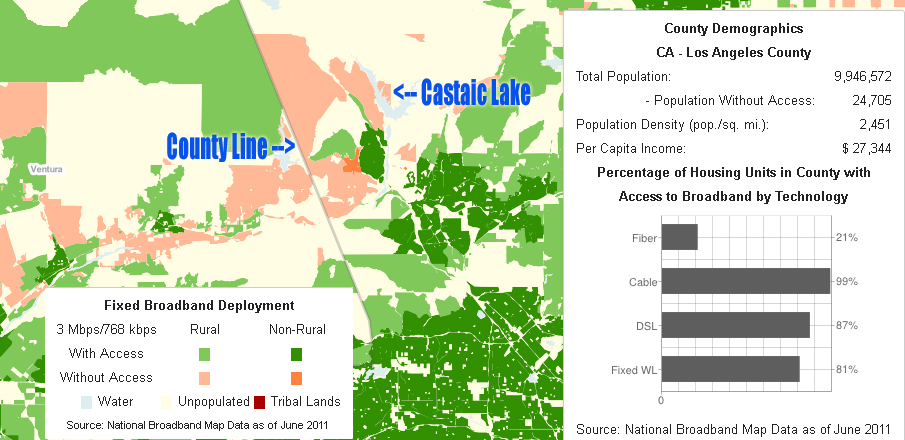The Federal Communications Commission issued a report Tuesday saying that while progress has been made, some 19 million Americans – 6 percent of the population – still lack broadband Internet availability, defined as download speeds of 3MB per second or better.
A detailed map of the nations shows that while broadband service is available throughout most of the Santa Clarita Valley, parts of the Hasley Canyon-Castaic area haven’t seen fixed broadband deployment.
The FCC’s statement about the report follows.
Washington, D.C. – The nation has made significant progress expanding high-speed Internet access in recent years, but further implementation of major reforms newly adopted by the Federal Communications Commission is required before broadband will be available to the approximately 19 million Americans who still lack access, according to the FCC’s Eighth Broadband Progress Report.
In an era when broadband is essential to innovation, jobs, and global competitiveness, the Report concludes that the FCC – and the nation – must continue to address obstacles impeding universal broadband deployment and availability.
Congress in Section 706 the Telecommunications Act of 1996 requires the FCC to report annually on whether broadband “is being deployed to all Americans in a reasonable and timely fashion.” The Report chronicles major strides taken by providers and policymakers to accelerate deployment, including:
* Billions invested by the communications industry in broadband deployment, including next-generation wired and wireless services
* Expansion of networks technically capable of 100 megabit-plus speeds to over 80 percent of the population through cable’s DOCSIS 3.0 rollout
* World-leading LTE deployment by mobile operators
* Sweeping reforms by the FCC to its universal service programs, including the new Connect America Fund for broadband deployment, Mobility Fund, and the Lifeline program for low-income Americans
* Action under the FCC’s Broadband Acceleration Initiative to reduce the cost and time required for deployment
* Numerous steps to expand availability of wireless spectrum for broadband
Notwithstanding this progress, the Report finds that approximately 19 million Americans—6 percent of the population—still lack access to fixed broadband service at threshold speeds. In rural areas, nearly one-fourth of the population —14.5 million people—lack access to this service. In tribal areas, nearly one-third of the population lacks access. Even in areas where broadband is available, approximately 100 million Americans still do not subscribe. The report concludes that until the Commission’s Connect America reforms are fully implemented, these gaps are unlikely to close. Because millions still lack access to or have not adopted broadband, the Report concludes broadband is not yet being deployed in a reasonable and timely fashion.
Having good data is critical to attacking these problems, and this Broadband Progress Report arms the FCC with the best information it has had yet on broadband in the U.S. This is our first progress report ever to include extensive data on mobile broadband and the availability of next-generation, high-speed services. It incorporates the most robust analysis of international data that the Commission has ever done. The report includes online, interactive maps which show exactly where broadband is and isn’t available, and deployment statistics—by technology type—for every county in the nation.
Technology and the needs of businesses and consumers continue to evolve, the FCC notes in a Notice of Inquiry also released today that seeks public input for the next annual report. Because higher-speed broadband is increasingly available and market offerings continue to change, the Notice of Inquiry explores how to keep the broadband report up-to-date, including further examining the role of mobile services and next-generation, high-speed services in the FCC’s next annual evaluation of broadband availability.
Like this:
Like Loading...
Related





 Tweet This
Tweet This Facebook
Facebook Digg This
Digg This Bookmark
Bookmark Stumble
Stumble RSS
RSS




























REAL NAMES ONLY: All posters must use their real individual or business name. This applies equally to Twitter account holders who use a nickname.
No Comments